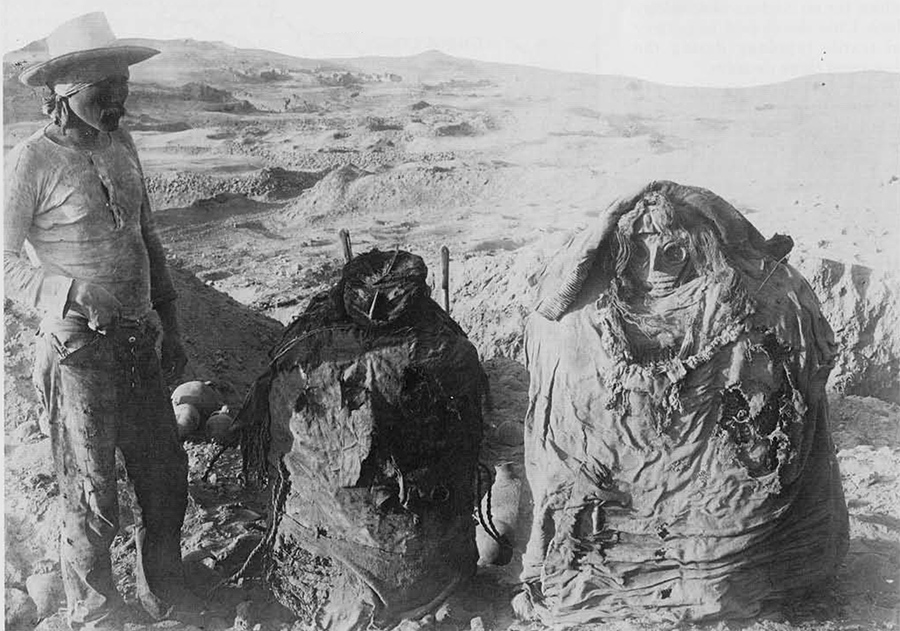
While, in the wake of Johann Winkelmaun’s appraisal of the Greek contribution to art and of the scholarship stimulated by Napoleon’s occupation of Egypt, the tempo of research quickened throughout the Classical World and the Near East, the 18th and 19th centuries were a subdued period in New World archaeology. Most 19th century travelers in Mesoamerica and the Andean hinterland concerned themselves only with the description of the more conspicuous monuments and the collection of curiosities. There were, however, home academic efforts in the 1880s (including field expeditions such as Maudslay’s to the Maya area) that began to hint at the richness of archaeological heritage that the New World could offer. Ernst Förstemann’s work on Maya arithmetic and his subsequent study of the inscriptions at Copan were pivotal to an understanding of the Maya calendric system; and Wilhelm Riess and Alphas Stübel’s publication The Necropolis of Anon in Peru (1880-87) caused a sensation in anthropological circles, not least because of its sketches of mummy bundles still perfectly preserved in their sandy burials.
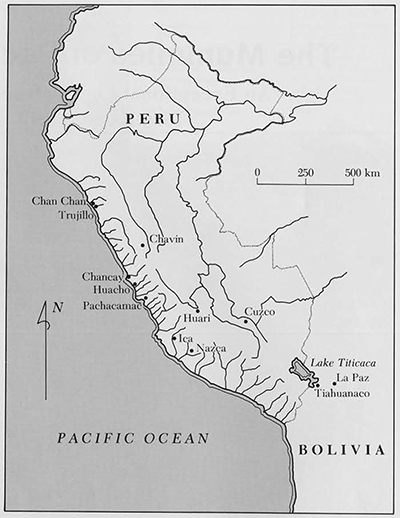
At that time a young linguist-cum-ethnographer named Max Uhle was working in Dresden as assistant director of the Königlisches Zoologisches and Anthropologisch-Ethnographisches Museum. He had already gained some reputation for his writing on various aspects of tribal life in Malaya and New Guinea, but he now met Stübel ands his mind was filled thereafter only with matters Andean. In 1888 he moved to Berlin to work with Adolf Bastian, already a seasoned Andean traveler. Uhle’s first publication on South America was an important paper on the phonetics of Chibcha languages. He then wrote Die Ruinenstätte von Tiahuanaco (1892), a detailed architectural interpretation of that major Bolivian site, based upon photographs and measurements made by Stübel some 15 years earlier. That volume established the style of Tiahuanaco as pre-Inca in date, and laid the foundations for an Andean chronology which Uhle developed in pottery and textile typology during the subsequent three decades.
These historical matters are relevant to the focus of this paper—the mummies from the Peruvian site of Pachacamac–in an unusual way. Like many of his colleagues, Uhle could have gained ample academic stature without ever leaving Germany. But the possibility of excavating at Tiahuanaco lured him into the field, and into a quite unexpected controversy. In the spring of 1894 he found not the silent ruins so familiar to him from Stübel’s field notes, but a Bolivian regiment using the site’s sculpture for rifle practice. His reports of this vandalism were effective in stopping it, but they also led the Bolivian government to ban all digging at Tiahuanaco, a ban which they somewhat vindictively extended to Uhle as well. So it was that, in January of 1896, he expressed himself “utterly wearied of Bolivia,” and crossed into Peru. If Uhle had not turned his back on Tiahuanaco in sorrow, he might never have excavated Pachacamac in his systematic fashion, and its potential contribution to Andean archaeology might never have been fulfilled.
The Cemeteries
Back in 1893, a Mrs. Zelia Nuttall was in Berlin and heard of the early success of Uhle’s field work. She suggested to Mrs. Cornelius Stevenson, a patroness of the University of Pennsylvania, that the University assume sponsorship of his activities. Stevenson’s fund-raising efforts did not, however, go smoothly, and so it was not until Uhle was settling into Lima that he came firmly under American patronage.
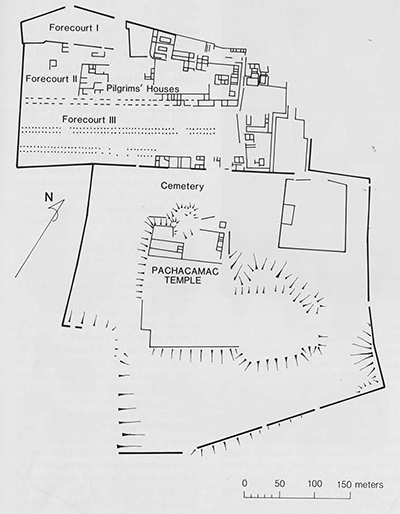
Almost immediately he began an excavation at Ancon, but the coastal site of Pachacamac (30 kilometers south of Lima; Fig. 2) was soon to absorb all his attention. There he revealed a stratigraphy of remarkable depth and cultural diversity, with cemeteries that, in their spatial planning, retained quite well many aspects of the socioeconomic history of Pachacamac.
An Inca presence was obvious in the sectors of the township of Pachacamac that sprang up after the forces of the Inca ruler Topa Inca subjugated the area in 1465, and in the temple complex, dedicated to their sun god Inti, that straddled a southern hilltop. On the southeastern terrace of the complex, there was a cemetery that was clearly set apart for the burial of the mainacuna (“Virgins of the Sun”), a group of women holding a privileged position in the temple’s services. In life they took responsibility for the weaving of textiles worn by the priests, and made the corn beer (chica) that figured in so many Inca festivals. In sacrificial death, they were accorded the highest ritual. All these women at Pachacamac had been strangled—many still have the cotton garrote twisted about their throats—wrapped in fine cloth, and then buried in stout, stone-lined tombs. Each was surrounded by funerary offerings of foodstuffs that were specific to the Peruvian highlands—coca, quinoa, cayenne pepper —rather than the local varieties of plants found in tombs elsewhere at Pachacamac. The aim was obviously to replicate the rituals involving human sacrifice that were enacted every year at the Inca capital of Cuzco.
Further to the north, and at a lower elevation, lay what was surely the religious focal point of the area for the local people: the sprawling temple dedicated to Pachacamac, Creator of the Universe and protector of the crops, but bringer of earthquakes for those who neglected his cult. It is said that during the reign of Huayna Capac, Topa’s successor in 1493, the temple’s walls were lavishly redecorated with colorful scenes of animals and birds, its inner door encrusted with coral and turquoise, and its shrine adorned with gold ornaments that were personally donated by the Inca. (Word of that gold was what attracted Hernando Pizarro to Pachacamac in 1533, and led to the shrine’s destruction when he found that the local people had managed to remove everything of value before the conquistadors got there.) The entire 16,000 square meters between the temple’s main entrance and the northern wall of its inner forecourt comprised several soil levels, all of which were choked with remnants of thousands of graves that had been destroyed, generation after generation, to make room for new ones (Fig. 3).
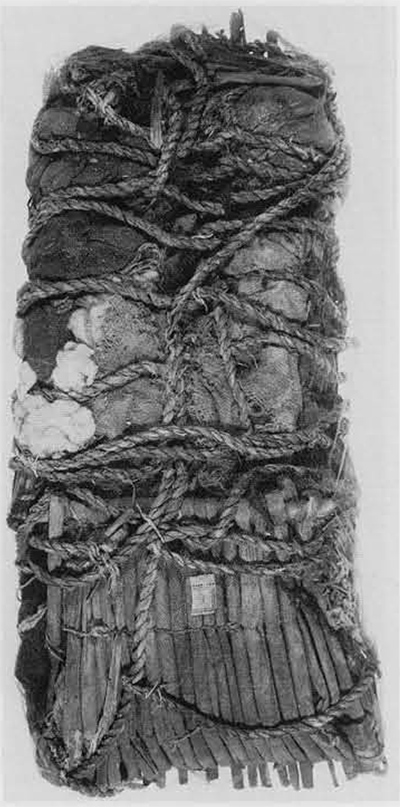
A small sector of this area, close to a terrace at the temple’s doorway, contained burials of individuals who shared a common feature: their hair was cropped short, often to within half a centimeter of the scalp. These individuals were surely high-ranking officials in the Inca political system (if not its nobles, sent to the provinces), since later Spanish sources indicate that the Incas applied a strict regulation to the hair length of their representatives, the Inca ruler himself being most closely cropped of all. These officials sought, by proximity to Pachacamac’s shrine, a favored degree of protection from that god in their afterlife.
What do we know of Pachacamac’s earlier worshippers? The care with which Uhle excavated the temple region allowed him to set up a reliable relative dating scheme for the grave sequences and their contents. From that scheme it became clear that much of the reuse of the Pachacamac cemetery dated quite late in the temple’s history, perhaps because burial privileges within its inner sanctuary were only belatedly extended to wealthy pilgrims. Underneath the northern terrace mentioned earlier, Uhle found a series of far better preserved strata of graves, the earliest of which date to about the late 6th century A.D. The myriad of grave goods throughout these strata—baskets of foodstuffs, grain vessels and wine gourds, fishing and farming implements—all indicate that the notion of an afterlife as a perfect form of everyday existence was prevalent throughout the times when Pachacamac was under the control first of the Huari and then of the Chime (from the early 9th century A.D. forward). The care with which the mummies within the graves were prepared indicates a determination to preserve the deceased for eternity (Fig. 4).
The construction of the northern terrace probably dated to the late 11th or early 12th century A.D., and the upper stratum of burials beneath to the previous three centuries. Uhle noted that these burials were poorly preserved, because their lightweight roofing of woven rush stems had invariably collapsed under the weight of accumulated soil and terrace stonework eventually laid over it. He noted too that the mummies and associated grave goods in the burials had suffered accordingly, but unfortunately he provided no description of how the mummies were prepared.
A lower stratum about 3 meters down was, however, well documented. Tombs within it had stood up to the pressures of the overburden because they were sturdily constructed of stone and mud brick, both in their walls and in their roofing. Many had a characteristic conical shape, perhaps in imitation of a local architectural tradition.
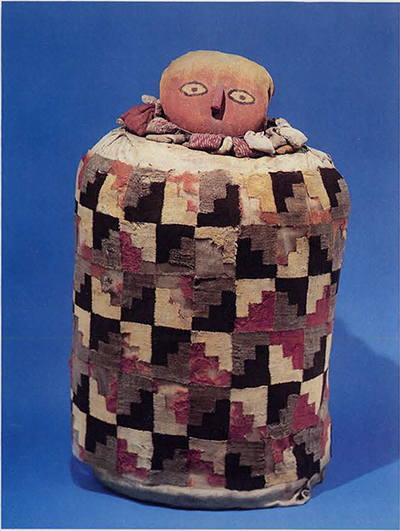
The mummies in these tombs were invariably in the shape of a bale with a false head attached at the top. Some of the heads were carved in wood, with eyes of inlaid shell; others were fashioned of pottery, made more lifelike by rough earthtone coloring and feature outlining; others again were simply painted cushions stuffed with stems and leaves of the local Tillandsia plant. Each bale, with a wrapped body at its core, was stuffed with leaves of the local fruit trees — usually, the pacae and the avocado—and made rigid by a basketlike cane frame. This frame also held taut the two or more cotton shrouds that were laid over it.
It is this early group of tombs that have provided the core of The University Museum’s Peruvian mummy collection, and the bulk of its holdings of Pachacamac artifacts. Many of these mummies have deteriorated to some degree over the past 90 years of storage, the sealed environment of an underground tomb being more conducive to their preservation than exposure to the modern atmosphere. Several of them have, however, recently undergone conservation treatment, and their contents have been partially documented via a series of radiographic examinations. These technical studies have revealed an example of infant sacrifice (Museum inv. no. 26628; see Bibliography), and an instance of a relatively rare childhood health problem (in mummy bale, Museum inv. no. 26626), the nature of which has posed something of a medical enigma.
Mummy Bale No. 26626
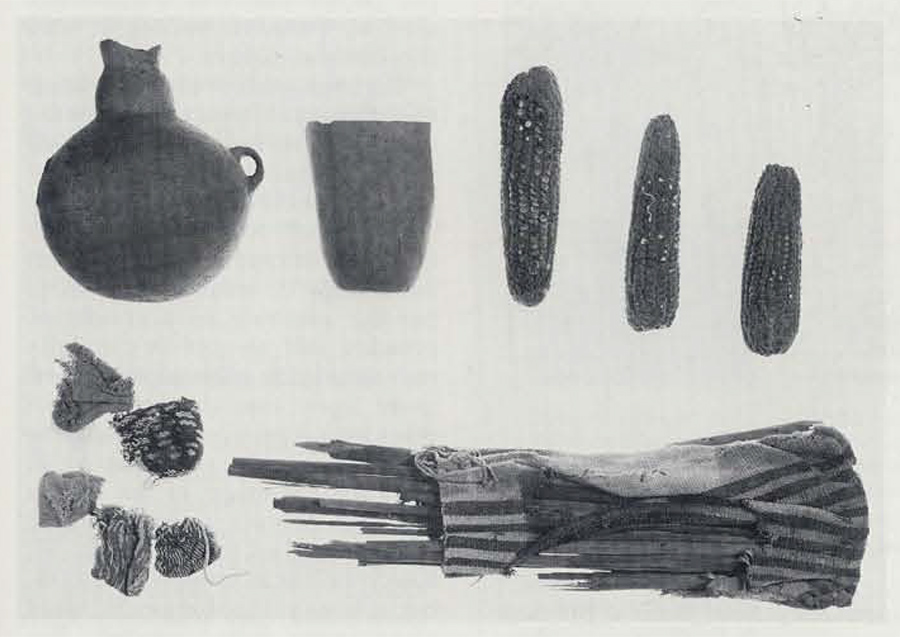
Uhle’s file’s original field notes quite blandly recorded a find, no. 1044, as a mummy bale, and thereafter gave a lengthy list of grave goods which surrounded the bale (Figs. 5-7). As blandly, that bale has been inventoried in the Museum as no. 26626, with little comment other than on the quality of the outer shroud. The body of the child within, however, offers an excellent illustration of a number of practical aspects of ancient Peruvian funerary procedures that seem to have been standard at Pachacamac and at many other coastal cultural centers from the early 1st millennium B.C. through to the Inca period.
X-rays taken from various aspects around the bale’s girth indicate that the body was mummified in a deliberately tightly flexed position. The orientation and spacing of several bone groups are consistent with there being substantial amounts of cartilage between them, and the cloth swathing just discernible around the body is not in direct contact with the bone surfaces. It is almost certain that body preservation was induced by natural processes, as opposed to being a result of any artificial embalming procedures. A late 16th century Spanish chronicler, Blabs Valera, did note that it was an Inca practice for body organs to be removed soon after an individual’s death—an effective measure, because those organs are among the first to putrefy and attract corrupting bacteria—and that Tolu balsam was rubbed on the flesh’s surface as a preservative. This treatment may have been a privilege extended only to the very wealthy, however, and then only infrequently employed; none of the Peruvian mummies studied in recent years, whether contemporary with or later than bale no. 26626, appear to have been prepared in such an elaborate fashion.

Judging by the descriptive consistency of several other Spanish accounts of Inca funerary practices, it was more usual for body treatment to be limited to a rubbing of fragrant herbs on the skin, and a tight bandaging of the body to exclude the corruptive effects of exposure to the air. It is also possible that for some time after the mummy’s initial interment, it was accessible not only to mourners who brought offerings but also to special attendants who undertook chores such as a changing of the bale’s “clothes.” A regular replacement of the body’s most immediate wrappings will have much increased the chances of its long-term survival.
That the deceased within bale no. 26626 was a child was clear both from the physical size and immaturity of the long bones and from the fact that several of the teeth were unerupted. Age at death was close to 12 years, with little more than a year’s uncertainty either way. There was nothing in the bone structure that would indicate the child’s sex, but a filament-like opacity in an x-ray image of the upper chest has the form and size of the kind of bronze pin (topu) that was traditionally used by Peruvian women to hold together the folds of a shawl.
The large wads of cotton padding that were surely used to bulk out the interior of the bale tend to blur all the x-ray images of the body below the head, so it is difficult to say what other artifacts may be caught up in the inner wrappings. Several small items might be ornamental jewelry, but the presence of a couple of pouches full of weaver’s spindle rods among the grave goods make it more likely that those items are other tools used in weaving, such as stone (or ceramic) whorls.
As for the cause of the child’s death, there is one clear sign in the x-ray images of the skull (Fig. 9). Everyone’s skull comprises a number of bony plates that key together along seams called sutures. This keying is normally quite tight except during the early years of childhood, but a number of serious diseases can cause an excessive intracranial pressure that will force the sutures to separate. The fact that our Pachacamac girl was suffering from such a skull condition suggests that she may well have had tuberculous meningitis, or a well advanced brain tumor.
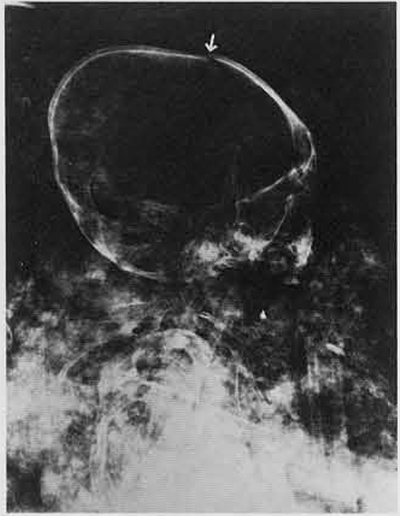
The symptoms of intracranial pressure that the girl will have displayed include complaints of recurring headaches, bouts of vomiting, and a growing, moody indifference to activities going on around her. The treatment of associated pain was well within the compass of pre-Inca herbal medicine, since coca (Erythroxylon novograntense) and several other less powerful plant-based narcotics were readily available. Yet Peruvian herbalism could not offer a cure for this disorder, so we would have expected that the outward sign of the child’s problems—a bulging of the skull’s outline—would have attracted a much closer scrutiny. Herein lies the medical enigma of this mummy: no attempt was made to trephine the skull bone and search out the source of the excess pressure. Trephination by at least four different methods is well documented in ancient Peru, with a success rate of greater than 50 percent (judging by the extent of bone healing around the point of surgery), despite the very real risks of secondary infection that accompanied the procedure. And the family of the girl in the bundle must have had a quite high social status for her to have attained such proximity to the Pachacamac shrine in death, i.e., cost or a lack of political influence should not have been a barrier to surgical intervention. Nonetheless, her illness was allowed to run its full course.
A Look to the Future
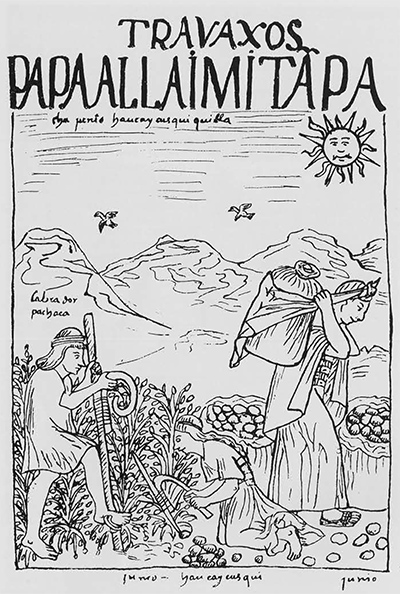
Within a decade, this medical story and all the other paleopathological data which the Museum’s other Pachacamac mummies have provided will be but a small piece in a wide-ranging mosaic of information about the in-life health status and the in-death funerary customs of ancient Peruvians. Academic attention is now focusing on the possibility that a heavy dependence upon maize in the daily diet may have encouraged a widespread incidence of iron and protein deficiencies, and that cassava’s use as a food staple could have caused a high incidence of congenital abnormalities, such as dwarfism and spina bifida.
There is also growing evidence, from autopsy of mummy tissue, that a primary killer in the New World, long before the Europeans transmitted smallpox and other Old World diseases to the Aztec and Inca peoples with such devastating effect, was the familiar respiratory disease pneumonia. Vast. but only recently excavated cemeteries at several sites along the ‘northern Peruvian coastline are yielding up the numbers of well-preserved skeletal remains that will allow paleopathologists to make statistical estimates of disease prevalence, life expectancy, and genetic change through time. Yet Uhle’s contribution to the reconstruction of the Andean past will never be diminished, purely on grounds of scale. Pachacamac’s mummies are an Uhle legacy with, I suspect, many more secrets within them for us to discover.
Stuart Fleming is Scientific Director of the Museum Applied Science Center for Archaeology (MASCA) at The University Museum. He is the author of four books, including Authenticity in Art (1975), co-author of the Museum’s handbook The Egyptian Mummy: Secrets and Science (1980), and for the past six years has been science correspondent to Archaeology magazine through its regular column Science Scope.
